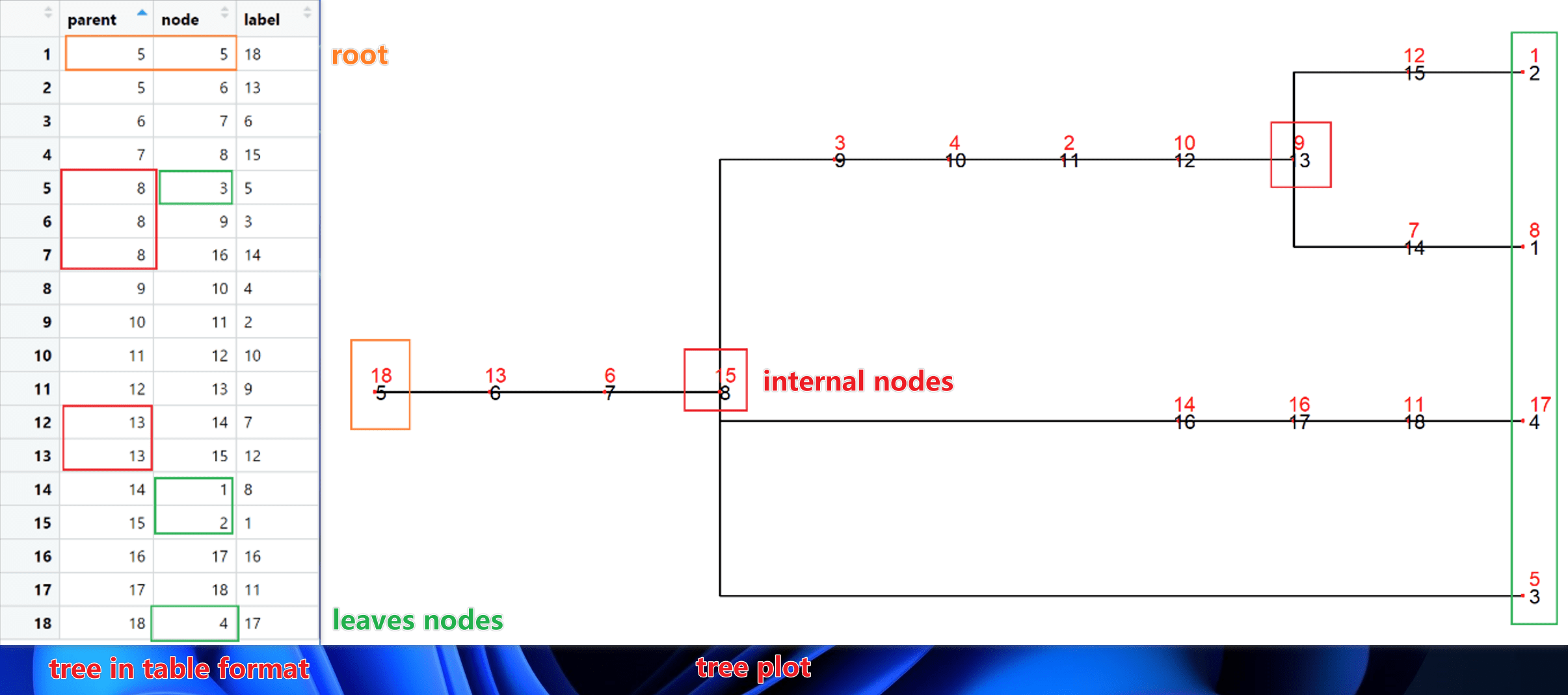Stack_Mutation_Principle
Source:vignettes/Stack_Mutation_Principle.Rmd
Stack_Mutation_Principle.Rmd
library(converTree)
suppressMessages(library(ggtree))
suppressMessages(library(treeio))
library(gridExtra)Every mutation tree from infSCITE is formatted as parent Vector in sample file. For example:
pvtre <- "11 2 3 14 14 16 8 6 9 1 15 8 10 14 5 13 17"We can reformat it to nwk that is a format easy to be visualization.
# reformat
reformatParentVector <- function(pvtre) {
lapply((strsplit(pvtre,"[ ]",)), function(x){
as.integer(x)
}) |> unlist()
}
pvtre1 = reformatParentVector(pvtre)
# convert to nwk
nwk_text <- parentVector2nwk(pvtre1,17)
nwk_text
#> [1] "((((((((((8)7,(1)12)9)10)2)3)4,5,(((13)11)16)14)15)6)17)18;"Plot a mutation tree. In order to clearly display the structure of the tree. Red points and red numbers represent a mutation node (label in table). Black numbers mean the order of node in tree, from leaves to internal nodes (parent and node in table).
tre <- treeio::read.newick(text = nwk_text)
mtr <- ggtree(tre) +
geom_nodepoint(size = 1,color = "red",shape = 20) +
geom_nodelab(color = "red",nudge_y = 0.1)+
geom_nodelab(aes(label = node))+
geom_tippoint(size = 1,color = "red",shape = 20)+
geom_tiplab(color = "red",nudge_y = 0.1)+
geom_tiplab(aes(label = node))
tre_dat <- tre %>% as_tibble()
tre_table <- gridExtra::tableGrob(tre_dat, theme = ttheme_minimal())
gridExtra::grid.arrange(tre_table, mtr, nrow = 1,widths = c(1,2))
Mutation Tree

Root, leaf and internal nodes will be kept and recode and all node in branch will move to the nearest node.
For example, node 6 and 7 with label 13 and 16 will move to node 8 and node 8 will re-code to 6 for root is 5 and re-label with 13,6,15. More addition, branch length will be changed according to mutation number.

stack_mutationTree() can be used to complete the transform of re-code and re-label.
stre <- stack_mutationTree(tre)Lets check what happened.
mtrs <- ggtree(stre)+
geom_nodepoint(size = 1,color = "red",shape = 20) +
geom_nodelab(color = "red",nudge_y = 0.1,nudge_x = -0.4)+
geom_nodelab(aes(label = node))+
geom_tippoint(size = 1,color = "red",shape = 20)+
geom_tiplab(color = "red",nudge_y = 0.1,nudge_x = -0.4)+
geom_tiplab(aes(label = node))+
theme_tree2()+
scale_x_continuous(breaks = c(0:10), limits = c(0,12))
tre_dats <- stre %>% as_tibble()
tre_tables <- gridExtra::tableGrob(tre_dats, theme = ttheme_minimal())
gridExtra::grid.arrange(tre_tables, mtrs, nrow = 2)